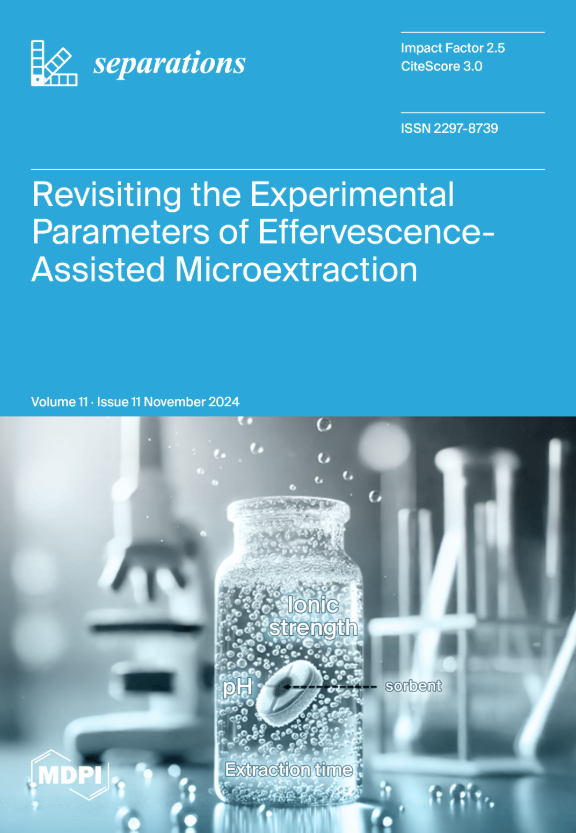Synthesis of Polyaluminum Chloride Coagulant from Waste Aluminum Foil and Utilization in Petroleum Wastewater Treatment
IF 2.7
4区 工程技术
Q3 CHEMISTRY, ANALYTICAL
引用次数: 0
Abstract
This work investigates the potential synthesis of cost-effective polyaluminum chloride (PACl) coagulant from waste household aluminum foil and utilization for treating petroleum wastewater (PWW), especially dissolved organic compounds (DOC, like octanol–water mixture) and nonsettleable suspended (NSS-kaolin) mineral particles. Based on the Standard Practice for Coagulation–Flocculation Jar Test, the efficiency of PACl for DOC and NSS removal was evaluated in relation to the effects of the operational parameters. The results demonstrated that the as-prepared PACl has an amorphous morphology with a Keggin-type e-Al13 molecular structure {Na[AlO4(OH)24(H2O)]·xH2O and good thermal stability up to 278 °C. PACl coagulant also exhibited a higher efficiency for NSS removal than DOC by around 1.5- to 1.9-fold under broad pH (5–7), while a higher acidic/alkaline pH disrupts the sweep floc formation. An increased PACl dosage (over 25 mg/L) also caused a decrease in the coagulation efficiency by 11.7% due to Al species’ transformation and pH depression (from 6.8 to 4.9) via increased PACl hydrolysis. With a fast rotating speed of 280 rpm for 2 min, the minimum dose of PACl (10–25 mg/L) can maximize the removal efficiency of NSS (~98%) and DOC (~69%) at pH 6.5 ± 0.5 and 35 °C after 30 min of settling time. Treating actual saline PWW samples (salinity up to 187.7 g/L) also verified the high efficacy of PACl coagulation performance in reducing the turbidity and dissolved hydrocarbons by more than 75.5% and 67.7%, respectively. These findings verify the techno-economic feasibility of the as-prepared PACl coagulant in treating PWW treatment at different salinity levels.从废铝箔中合成聚合氯化铝混凝剂并用于石油废水处理
本研究探讨了从废旧家用铝箔中合成具有成本效益的聚合氯化铝(PACl)混凝剂并用于处理石油废水(PWW)的可能性,尤其是溶解性有机化合物(DOC,如辛醇-水混合物)和非沉降性悬浮(NSS-高岭土)矿物颗粒。根据《混凝-絮凝罐试验标准操作规程》,结合操作参数的影响,对 PACl 去除 DOC 和 NSS 的效率进行了评估。结果表明,制备的 PACl 具有无定形形态,分子结构为 Keggin 型 e-Al13 {Na[AlO4(OH)24(H2O)]-xH2O,热稳定性良好,温度可达 278 ℃。在较宽的 pH 值(5-7)条件下,PACl 混凝剂去除 NSS 的效率也比 DOC 高约 1.5-1.9 倍,而较高的酸性/碱性 pH 值会破坏絮凝体的形成。增加 PACl 的用量(超过 25 毫克/升)也会导致混凝效率降低 11.7%,原因是 Al 物种的转化以及 PACl 的水解作用导致 pH 值降低(从 6.8 降至 4.9)。在 pH 值为 6.5 ± 0.5 和温度为 35 ℃ 的条件下,以 280 rpm 的快速转速运行 2 分钟,在沉淀 30 分钟后,最小剂量的 PACl(10-25 mg/L)可最大限度地提高 NSS(~98%)和 DOC(~69%)的去除率。在处理实际的含盐污水样本(盐度高达 187.7 g/L)时,也验证了 PACl 混凝技术在降低浊度和溶解碳氢化合物方面的高效性能,降幅分别超过 75.5% 和 67.7%。这些研究结果验证了制备的 PACl 混凝剂在处理不同盐度水平的污水处理方面的技术经济可行性。
本文章由计算机程序翻译,如有差异,请以英文原文为准。
求助全文
约1分钟内获得全文
求助全文
来源期刊

Separations
Chemistry-Analytical Chemistry
CiteScore
3.00
自引率
15.40%
发文量
342
审稿时长
12 weeks
期刊介绍:
Separations (formerly Chromatography, ISSN 2227-9075, CODEN: CHROBV) provides an advanced forum for separation and purification science and technology in all areas of chemical, biological and physical science. It publishes reviews, regular research papers and communications. Our aim is to encourage scientists to publish their experimental and theoretical results in as much detail as possible. There is no restriction on the length of the papers. The full experimental details must be provided so that the results can be reproduced. There are, in addition, unique features of this journal:
Manuscripts regarding research proposals and research ideas will be particularly welcomed.
Electronic files and software regarding the full details of the calculation and experimental procedure, if unable to be published in a normal way, can be deposited as supplementary material.
Manuscripts concerning summaries and surveys on research cooperation and projects (that are funded by national governments) to give information for a broad field of users.
The scope of the journal includes but is not limited to:
Theory and methodology (theory of separation methods, sample preparation, instrumental and column developments, new separation methodologies, etc.)
Equipment and techniques, novel hyphenated analytical solutions (significantly extended by their combination with spectroscopic methods and in particular, mass spectrometry)
Novel analysis approaches and applications to solve analytical challenges which utilize chromatographic separations as a key step in the overall solution
Computational modelling of separations for the purpose of fundamental understanding and/or chromatographic optimization
 求助内容:
求助内容: 应助结果提醒方式:
应助结果提醒方式:


